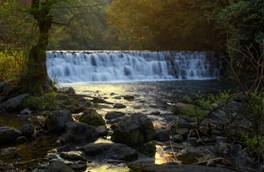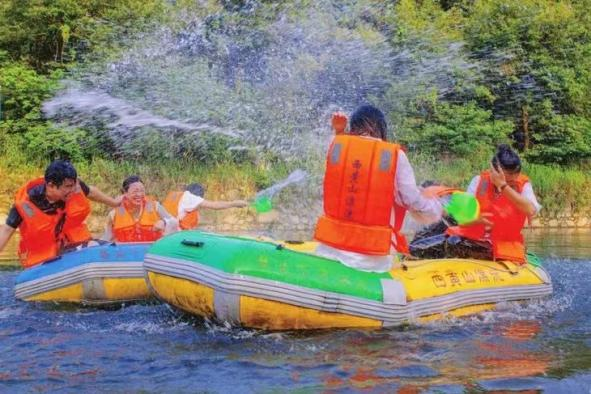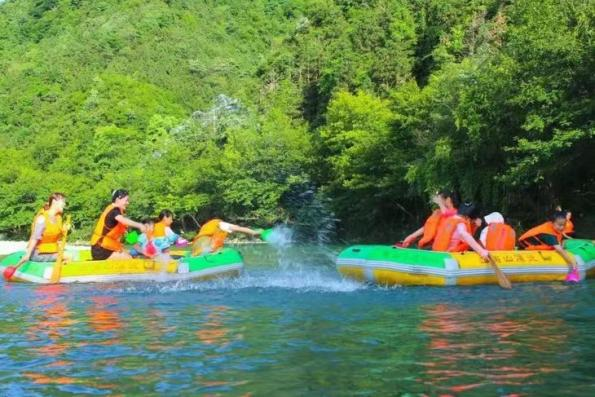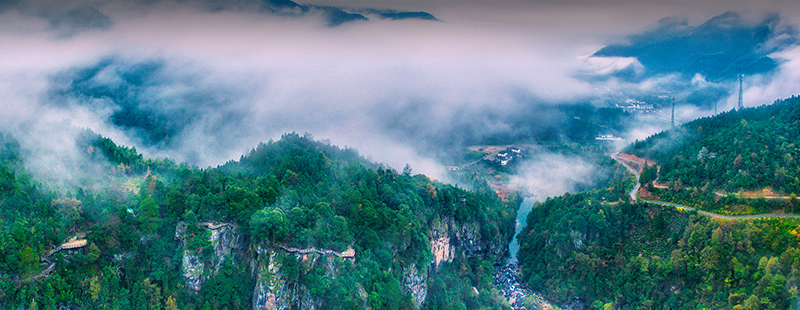【2-Day tour】Shitai Gu Niu Descent + Penglai Xiandong + West Huangshan Rafting
Release Date:2024-06-25 Source: Number of views:184
Day One
Set off in the morning for Shitai, the most beautiful mountainous countryside with original ecology in China - a natural oxygen bar.
In the afternoon, visit [Penglai Fairy Cave] (the tour time is about 2 hours), a national 4A-level scenic spot.


The Penglai Fairy Cave Scenic Area is located in Shitai County, Chizhou City, China. It is the hometown of Du Xunhe, a famous poet in the late Tang Dynasty. The Penglai Fairy Cave Scenic Area is a cave landscape full of geological interest. The entire cave body presents a multi-level, multi-stage, and multi-accumulation form. With a total length of more than 3,000 meters and a total area of more than 20,000 square meters, it has an interchange structure. It is divided into four levels: the upper cave, middle cave, lower cave, and underground river. It has unique shapes, winding and looping, magnificent momentum, and beautiful sceneries everywhere. There are more than 10 scenic spots such as the welcome hall, the exploration sea promenade, the East China Sea Dragon Palace, the Tongming Palace, the Lost Immortal Palace, the Yuchan Palace, the Milky Way promenade, the Jade Pool, the South China Sea, the Chaoyin Palace, and the farewell hall, which are all wonderful. The lower cave has huge rocks of different shapes and a continuous underground river. The middle cave is covered with exquisite stalactite groups, which are lifelike and vivid. The upper cave is grand and beautiful, winding and deep, with strange landscapes. Among them, the extremely beautiful "landscape mural", the flawless "gauze curtain", the crystal clear "celestial silk", and the majestic "Thousand Buddha Mountain" form the "four wonders of Penglai". It can be called a natural geological museum and is known as the first of the Shitai cave groups. Every year, it attracts thousands of Chinese and foreign tourists. There is a saying that "after returning from Huangshan Mountain, there is no need to see other mountains; after returning from Penglai, there is no need to see other caves." After coming out of the cave, you can freely check in at [Tang Style Poetry Gallery - Wind Chime Corridor]. The sound of the wind chimes is clear and melodious. Here, you can empty your mind and listen to the sound of the wind chimes quietly. You can also make a wish and attach it to the wind chime.
The next day
Visit [Shitai Guniujiang Longmen Scenic Area] in the morning (touring time is about 3 hours). The Guniujiang scenic area in Shitai County, Anhui Province is a national comprehensive nature reserve mainly based on forest ecosystem approved by the State Council in 1988. It is called the "green natural museum" by ecologists. In 2010, it was awarded a national 4A-level scenic area. In 2019, it was selected as an "Anhui summer tourist destination". In 2021, it was selected as the first batch of forest health care bases in Anhui Province.


Guniujiang is the main body of the Huangshan Mountains extending westward. In ancient times, it was called "West Huangshan". Its main peak is 1,727.6 meters above sea level and is the third highest peak in southern Anhui Province. It is named Guniujiang because its mountain shape resembles a guiniu (bull) descending from the sky. Guniujiang has a total area of 6,700 hectares. It has ancient strata, superior climate, high mountains and dense forests, and is rarely visited by people. It preserves relatively complete natural forest vegetation and is one of the important typical areas of the evergreen broad-leaved forest belt in the subtropics of eastern China. Here, tourism resources are extremely rich, there are many kinds of organisms, the floristic elements are complex, and the ecological relationship is coordinated. At the same time, there are dangerous peaks, deep valleys, strange pines and rocks, and clouds and waterfalls in the area. The natural landscape is very magnificent... At present, the Longmen scenic area has been developed and opened.
The [Yan Family Ancient Village], the descendant of Yan Ziling, a famous hermit in the Eastern Han Dynasty. Here, ancient trees reach into the sky, the sound of pine waves is continuous, and streams flow gurgling. Residential houses and ancestral halls in Huizhou architectural style are hidden among them, presenting a scene of "cloudy trees merge by the village, and people live in a painting." This natural pure land, within the simple folk customs, permeates the indifference and purity that urbanites are desperately searching for. There are well-preserved ancient residential buildings, ancient mills, ancient ancestral halls, Candle Peak, Lover's Valley, Four-tiered Waterfall, etc. in the village. Later, through the items displayed in the [Shitai Red Culture Exhibition Hall] combined with picture and text introductions, vividly reproduce that eventful and smoky era, understand that exciting red history, and truly step into the well-known "hero village." Here, the red slogan wall left by Fang Zhimin who transferred to Guniujiang during the northern expedition against Japanese aggression is still preserved. Hiking in [Longmen Grand Canyon], there are crocodiles playing in the river, and the "Longmen Pool" with mythological colors. The pool water is as green as jade. The canyon is deep, the ecological corridor is full of wild charm, strange rocks are everywhere, and ancient trees are like covers. There are Baizhang Rock, Rolling Stone Beach, Qixian Cave, Hidden Moon Pool, Longmen Flying Crossing, Bell and Drum Stone, Jasper Pool, and the Small Great Wall in the south. It is truly a "silent poem and three-dimensional painting" created by nature.
The next day in the afternoon, go to [West Huangshan Rafting] for about 3 kilometers. The scenic spot is located in Yanxi Village, Dayan Township, Shitai County. It is a bright spot at the intersection of Guniu Descent Scenic Area and Xianfu Mountain Scenic Area. It is 15 kilometers away from the county seat and is located in the upper reaches of the Qiupu River. On both sides of the river, the peaks and mountains are steep and the water surface is shimmering, and tourists can take rubber boats to welcome the waves in the wave valley, which is thrilling and exciting; they can wash their hands and feet in the Qinglu River, leisurely and leisurely; they can go ashore to watch the rural field scenery, lyrical and nostalgic


Here, there are overlapping green mountains, beautiful scenery, lush vegetation, and pleasant views. Traveling by raft, one can enjoy many beautiful sceneries along the way, such as green mountains and clear waters, farmhouse fields, ancient trees and tea mountains. One can truly feel the artistic conception of "thinking there is no way out among the mountains, yet suddenly another village appears amid the shady willows and bright flowers." The Qiupu River is named because "its stream is clear and blue, as long as autumn." Due to the steep peaks on both banks along the river and the shimmering water surface, "the sceneries in four seasons are just like those of the Xiao and Xiang Rivers and Dongting Lake" (Records of the Unified Ming Dynasty). It has always fascinated many scholars and refined people, and there are many chants and praises. After the journey ends, take a bus back to the warm home and end the pleasant trip!
Day One
Set off in the morning for Shitai, the most beautiful mountainous countryside with original ecology in China - a natural oxygen bar.
In the afternoon, visit [Penglai Fairy Cave] (the tour time is about 2 hours), a national 4A-level scenic spot.


The Penglai Fairy Cave Scenic Area is located in Shitai County, Chizhou City, China. It is the hometown of Du Xunhe, a famous poet in the late Tang Dynasty. The Penglai Fairy Cave Scenic Area is a cave landscape full of geological interest. The entire cave body presents a multi-level, multi-stage, and multi-accumulation form. With a total length of more than 3,000 meters and a total area of more than 20,000 square meters, it has an interchange structure. It is divided into four levels: the upper cave, middle cave, lower cave, and underground river. It has unique shapes, winding and looping, magnificent momentum, and beautiful sceneries everywhere. There are more than 10 scenic spots such as the welcome hall, the exploration sea promenade, the East China Sea Dragon Palace, the Tongming Palace, the Lost Immortal Palace, the Yuchan Palace, the Milky Way promenade, the Jade Pool, the South China Sea, the Chaoyin Palace, and the farewell hall, which are all wonderful. The lower cave has huge rocks of different shapes and a continuous underground river. The middle cave is covered with exquisite stalactite groups, which are lifelike and vivid. The upper cave is grand and beautiful, winding and deep, with strange landscapes. Among them, the extremely beautiful "landscape mural", the flawless "gauze curtain", the crystal clear "celestial silk", and the majestic "Thousand Buddha Mountain" form the "four wonders of Penglai". It can be called a natural geological museum and is known as the first of the Shitai cave groups. Every year, it attracts thousands of Chinese and foreign tourists. There is a saying that "after returning from Huangshan Mountain, there is no need to see other mountains; after returning from Penglai, there is no need to see other caves." After coming out of the cave, you can freely check in at [Tang Style Poetry Gallery - Wind Chime Corridor]. The sound of the wind chimes is clear and melodious. Here, you can empty your mind and listen to the sound of the wind chimes quietly. You can also make a wish and attach it to the wind chime.
The next day
Visit [Shitai Guniujiang Longmen Scenic Area] in the morning (touring time is about 3 hours). The Guniujiang scenic area in Shitai County, Anhui Province is a national comprehensive nature reserve mainly based on forest ecosystem approved by the State Council in 1988. It is called the "green natural museum" by ecologists. In 2010, it was awarded a national 4A-level scenic area. In 2019, it was selected as an "Anhui summer tourist destination". In 2021, it was selected as the first batch of forest health care bases in Anhui Province.


Guniujiang is the main body of the Huangshan Mountains extending westward. In ancient times, it was called "West Huangshan". Its main peak is 1,727.6 meters above sea level and is the third highest peak in southern Anhui Province. It is named Guniujiang because its mountain shape resembles a guiniu (bull) descending from the sky. Guniujiang has a total area of 6,700 hectares. It has ancient strata, superior climate, high mountains and dense forests, and is rarely visited by people. It preserves relatively complete natural forest vegetation and is one of the important typical areas of the evergreen broad-leaved forest belt in the subtropics of eastern China. Here, tourism resources are extremely rich, there are many kinds of organisms, the floristic elements are complex, and the ecological relationship is coordinated. At the same time, there are dangerous peaks, deep valleys, strange pines and rocks, and clouds and waterfalls in the area. The natural landscape is very magnificent... At present, the Longmen scenic area has been developed and opened.
The [Yan Family Ancient Village], the descendant of Yan Ziling, a famous hermit in the Eastern Han Dynasty. Here, ancient trees reach into the sky, the sound of pine waves is continuous, and streams flow gurgling. Residential houses and ancestral halls in Huizhou architectural style are hidden among them, presenting a scene of "cloudy trees merge by the village, and people live in a painting." This natural pure land, within the simple folk customs, permeates the indifference and purity that urbanites are desperately searching for. There are well-preserved ancient residential buildings, ancient mills, ancient ancestral halls, Candle Peak, Lover's Valley, Four-tiered Waterfall, etc. in the village. Later, through the items displayed in the [Shitai Red Culture Exhibition Hall] combined with picture and text introductions, vividly reproduce that eventful and smoky era, understand that exciting red history, and truly step into the well-known "hero village." Here, the red slogan wall left by Fang Zhimin who transferred to Guniujiang during the northern expedition against Japanese aggression is still preserved. Hiking in [Longmen Grand Canyon], there are crocodiles playing in the river, and the "Longmen Pool" with mythological colors. The pool water is as green as jade. The canyon is deep, the ecological corridor is full of wild charm, strange rocks are everywhere, and ancient trees are like covers. There are Baizhang Rock, Rolling Stone Beach, Qixian Cave, Hidden Moon Pool, Longmen Flying Crossing, Bell and Drum Stone, Jasper Pool, and the Small Great Wall in the south. It is truly a "silent poem and three-dimensional painting" created by nature.
The next day in the afternoon, go to [West Huangshan Rafting] for about 3 kilometers. The scenic spot is located in Yanxi Village, Dayan Township, Shitai County. It is a bright spot at the intersection of Guniu Descent Scenic Area and Xianfu Mountain Scenic Area. It is 15 kilometers away from the county seat and is located in the upper reaches of the Qiupu River. On both sides of the river, the peaks and mountains are steep and the water surface is shimmering, and tourists can take rubber boats to welcome the waves in the wave valley, which is thrilling and exciting; they can wash their hands and feet in the Qinglu River, leisurely and leisurely; they can go ashore to watch the rural field scenery, lyrical and nostalgic


Here, there are overlapping green mountains, beautiful scenery, lush vegetation, and pleasant views. Traveling by raft, one can enjoy many beautiful sceneries along the way, such as green mountains and clear waters, farmhouse fields, ancient trees and tea mountains. One can truly feel the artistic conception of "thinking there is no way out among the mountains, yet suddenly another village appears amid the shady willows and bright flowers." The Qiupu River is named because "its stream is clear and blue, as long as autumn." Due to the steep peaks on both banks along the river and the shimmering water surface, "the sceneries in four seasons are just like those of the Xiao and Xiang Rivers and Dongting Lake" (Records of the Unified Ming Dynasty). It has always fascinated many scholars and refined people, and there are many chants and praises. After the journey ends, take a bus back to the warm home and end the pleasant trip!















